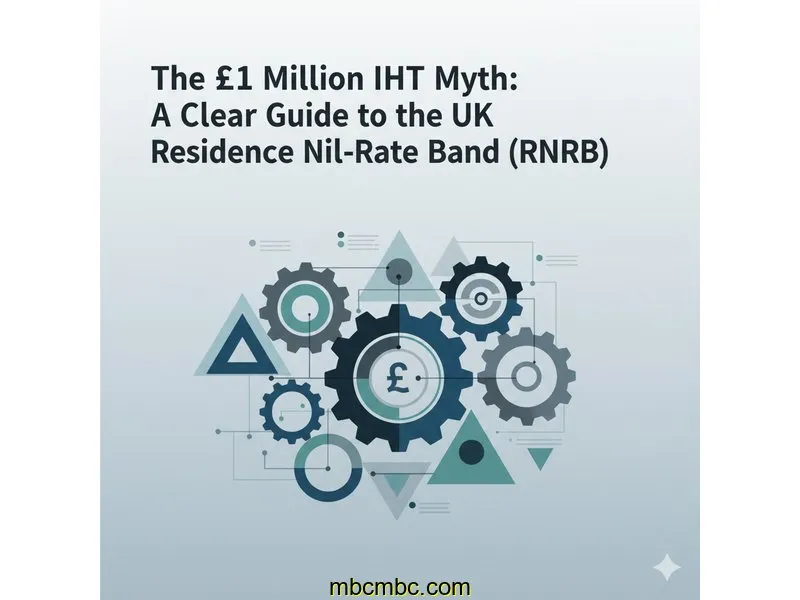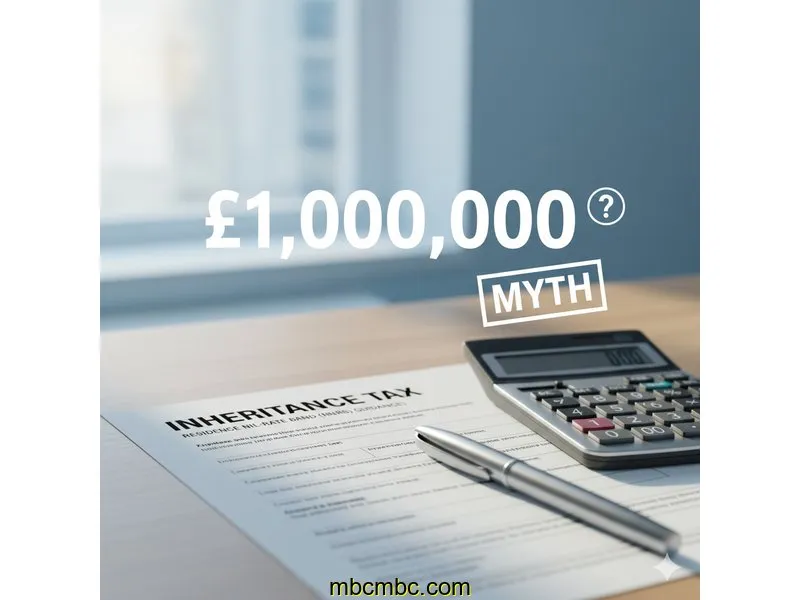
Hello, I'm Alex Williams, founder of FinTools UK. As a developer, I'm passionate about building tools that make complex financial topics clearer. One of the most confusing subjects I've come across is Inheritance Tax (IHT). You've probably seen headlines about a "£1 million tax-free allowance," but like many things in finance, the reality is a bit more complicated. That figure isn't a myth, but it's highly conditional.
The source of this £1 million figure is the combination of two separate allowances: the standard **Nil-Rate Band (NRB)** and the **Residence Nil-Rate Band (RNRB)**, often called the 'family home allowance'. Getting this £1m allowance isn't automatic—it depends entirely on your marital status, the value of your estate, and, most importantly, *who* you leave your home to.
This guide will break down exactly what the RNRB is, how it works, who qualifies for it, and how it can (or can't) combine with your standard allowance to reach that £1 million mark. Please remember, this article is for informational purposes to help you understand the concepts. It is not financial advice, as everyone's situation is unique.
Quick Summary: The RNRB Explained
- Standard Allowance (NRB): Every individual has a standard Inheritance Tax allowance of £325,000. This is known as the Nil-Rate Band (NRB).
- Home Allowance (RNRB): The Residence Nil-Rate Band (RNRB) is an *additional* allowance of £175,000.
- Key Condition: The RNRB only applies if you pass your main residence (your home) to your direct descendants (e.g., children or grandchildren).
- The £1m Figure: This comes from a married couple or civil partners. When the first partner passes, their unused allowances (both NRB and RNRB) can be transferred to the survivor. This gives the surviving partner:
- £325,000 (Own NRB) + £325,000 (Partner's NRB) = £650,000
- £175,000 (Own RNRB) + £175,000 (Partner's RNRB) = £350,000
- Total combined allowance = £1,000,000
- Important Caveat: This allowance can be reduced or lost completely if your total estate is valued at over £2 million.
First, What Is the Standard IHT Nil-Rate Band (NRB)?
Before we get to the family home, let's start with the foundation. Every person in the UK has a standard tax-free allowance for Inheritance Tax called the **Nil-Rate Band (NRB)**. For the 2024/2025 tax year (and frozen until 2028), this amount is £325,000.
This means that if the total value of your estate (your property, money, and possessions) is below £325,000, there is generally no Inheritance Tax to pay. Any amount *above* this threshold is typically taxed at 40%.
Crucially, for married couples and civil partners, any assets left to the surviving spouse are 100% tax-free. Not only that, but the first partner to pass away also passes their *unused* £325,000 NRB allowance to the survivor. This is how a surviving spouse can end up with a combined NRB of £650,000 (£325,000 x 2).
Adding the 'Family Home Allowance': The Residence Nil-Rate Band (RNRB)

This is where the £1 million figure starts to take shape. The **Residence Nil-Rate Band (RNRB)** was introduced to make it easier for people to pass on the family home to their children without a large tax bill. For the 2024/2025 tax year, this allowance is £175,000 per person.
Think of your standard £325,000 NRB as your main tax-free allowance that can cover any asset—cash, investments, or art. The £175,000 RNRB is like a special 'top-up' voucher that can *only* be used against the value of your home, and *only* if you leave that home to your children, grandchildren, or other direct descendants.
For a single person, this means they can have a total tax-free allowance of £500,000 (£325,000 NRB + £175,000 RNRB), provided their estate includes a home being left to their kids.
Just like the standard NRB, this £175,000 RNRB allowance is also transferable between spouses and civil partners. This is the final piece of the £1 million puzzle. A surviving spouse can potentially have:
- Their own £325,000 NRB + their late partner's £325,000 NRB = £650,000
- Their own £175,000 RNRB + their late partner's £175,000 RNRB = £350,000
Add those together (£650,000 + £350,000), and you get the £1,000,000 tax-free allowance. But this *only* works if all the conditions are met.
The Critical Rules: Who Really Qualifies for the RNRB?
This is where the "myth" part comes in, as many people assume this allowance is automatic. It is not. There are several strict conditions you must meet to use the RNRB.
1. You Must 'Closely Inherit' Your Home
This is the most important rule. The RNRB only applies if your home is left to your **direct descendants**. This includes:
- Children (including adopted, foster, or step-children)
- Grandchildren and great-grandchildren
- The spouses or civil partners of any of the above
It does **NOT** include nieces, nephews, siblings, or cohabiting (unmarried) partners. If you leave your home to your nephew, you cannot claim the £175,000 RNRB.
2. The £2 Million Taper Rule
This is the "big trap" that catches many larger estates. The RNRB is gradually reduced, or 'tapered', if the total value of your estate (your net assets *before* any allowances) is over £2 million.
For every £2 your estate is over the £2 million threshold, you lose £1 of the RNRB. This means that for a single person, the RNRB is completely lost if their estate is worth £2.35 million or more. For a couple with a combined RNRB of £350,000, the allowance disappears entirely if the surviving partner's estate is worth £2.7 million or more.
With Inheritance Tax receipts for the 2023/24 tax year reaching £7.5 billion (according to HMRC data), and with thresholds frozen while property prices have risen, more estates are being pushed into this tapering zone.
3. Downsizing Provisions
What if you sell your expensive family home to downsize or move into care? The rules here are complex, but in short, you may still qualify. If you sold your home on or after 8 July 2015, you may still be able to claim the RNRB (or an equivalent amount) as long as you leave other assets of equivalent value to your direct descendants in your will.
RNRB Qualification Scenarios: A Comparison
To make this clearer, I've built a simple HTML table (as I'm a developer, after all!) to show how these rules play out in different common scenarios.
| Scenario | Total Estate Value | Home Left To... | Total Tax-Free Allowance |
|---|---|---|---|
| Single person, owns home | £700,000 | Child | £500,000 (£325k NRB + £175k RNRB) |
| Single person, owns home | £700,000 | Nephew | £325,000 (RNRB does not apply) |
| Surviving spouse, owns home | £1.2 Million | Children | £1,000,000 (Full combined NRB + RNRB) |
| Unmarried (cohabiting) partner | £600,000 | Unmarried partner | £325,000 (No RNRB, no transfer of partner's allowance) |
| Single person, owns home | £2.5 Million | Child | £325,000 (RNRB is lost due to £2m taper) |
How Calculators Help Understand Your IHT Position
As you can see, your potential IHT liability isn't a simple number. It's a calculation that depends on multiple "if-then" conditions: *if* you're married, *if* you have a home, *if* you leave it to your children, and *if* your estate is below £2 million.
This is where an Inheritance Tax calculator becomes incredibly useful. A good calculator doesn't just ask for one number. It should allow you to model these different scenarios. It can help you see:
- The massive difference in the tax-free allowance between being married and cohabiting.
- The potential tax bill if you leave your home to a nephew instead of a child.
- The exact point at which the £2 million taper starts to reduce your RNRB.
- A clear estimate of how much of your estate could be liable for the 40% tax, helping you understand the scale of the issue.
By inputting your own figures, you can move from a vague "£1 million myth" to a concrete understanding of what your family's actual tax-free threshold might be.
Common Questions About the Residence Nil-Rate Band
When researching this topic, I see the same specific questions coming up again and again on forums. Here are the answers to the most common ones.
Do I lose the Residence Nil-Rate Band if I downsize my home or move into care?
Not necessarily. The rules include a "downsizing addition" for this exact situation. If you sold a home that would have qualified for RNRB (on or after 8 July 2015), you may still be able to claim an equivalent allowance, provided you leave other assets from your estate to your direct descendants.
Does the RNRB apply to unmarried or cohabiting partners?
This is a critical point: **no**. For IHT purposes, cohabiting partners are treated as separate individuals. You cannot transfer your unused NRB or RNRB to an unmarried partner. Furthermore, if you leave your home to your cohabiting partner, they are *not* a "direct descendant," so your estate cannot claim the RNRB allowance.
What happens to the RNRB if my total estate is over £2 million?
Your RNRB starts to 'taper' away. For every £2 your estate's *total value* is over the £2 million threshold, you lose £1 of your RNRB. For example, if your estate is £2.1 million, you are £100,000 over the limit. This means you would lose £50,000 (half of £100k) from your £175,000 RNRB, leaving you with only £125,000.
Conclusion: So, Is the £1 Million Allowance a Myth?
No, it's not a myth—but it's certainly not a guarantee. It's a *conditional* allowance that only applies to married couples or civil partners who pass their home to their direct descendants, and whose total estate is worth less than £2 million. It's an important and valuable relief, but it's crucial to understand the very specific rules that govern it.
I hope this guide has helped demystify the RNRB and given you a clearer picture of how these complex allowances fit together. Understanding these details is the first step in seeing how they might apply to your own circumstances. As always, this information is designed to explain the topic, not to provide advice for your personal situation.

